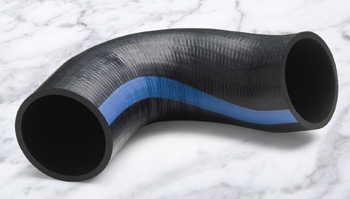“One thing fleet managers have learned,” says Darry W. Stuart, principal at DWS Fleet Management Services, an independent, limited-time executive transportation and fleet management business, “is that their choices may be limited when it comes to spec’ing certain vehicle components.”
For example, Stuart points out that due in part to the need to enhance aerodynamics, radiators have become primarily an OEM item. “We used to have options for radiator size and capacity,” he says, “but today fleets are limited to OEM designs on new vehicles. However, for out of warranty replacement, there are durable aftermarket radiators available that make economic and operational sense.
“Likewise, radiator hoses have become standard,” Stuart continues. “In this case, however, quality has improved measurably over the years so the n eed to spec a higher grade of hose is not really necessary. Some hoses will still fail but many will last the life of the truck.”
eed to spec a higher grade of hose is not really necessary. Some hoses will still fail but many will last the life of the truck.”
Proper PM
As always, Stuart recommends strict adherence to preventive maintenance procedures to ensure that hoses don’t fail on the road, where the breakdown of a relatively simple item can become costly.
Hose manufacturer Gates Corp. offers advice in this area as well. Routine inspections of vital components should include checking the cover of coolant hoses for signs of cracking, hardness or swelling, the company notes. “While this may indicate obvious symptoms of hose failure,” a Gates paper on the subject relates, “it doesn’t indicate the primary case of most coolant hose failures––an electrochemical attack on the tube compound inside the hose.
“Electrochemical degradation (ECD) occurs when an electrical charge takes place between dissimilar metals found in the cooling system, such as the aluminum engine block, cast-iron head, copper radiator core, or steel clamps,” the paper continues. “The electrical charge is carried between metals by the coolant, and damage first shows up as tiny cracks in the tubing. Accelerated by high under-the-hood temperatures and stop-and-go driving, these cracks become larger and deeper. This allows coolant to reach and degrade the reinforcement yarn. Eventually, the hose will rupture or leak.”
The best way to check coolant hose for the effects of ECD, according to Gates, is to squeeze the hose near the clamps or connectors using fingers and thumbs to check for weakness. “ECD occurs within two inches of the ends of the hose, not in the middle,” the company states. “Check for any difference in the feel between the middle and ends of the hose. If the ends feel soft compared to the solid feel of the middle of the hose, chances are, the hose is under attack by ECD.”
Fans and fan drives
“Today, OEMs tend to make fans and fan drives a package on new vehicles,” Stuart says. “Most standard offerings employ a fiberglass fan to save weight. While there are few options, depending on the vehicle, two- and three-speed fan drives are becoming more common for their ability to provide fuel savings.”
Horton DriveMaster DM Advantage two-speed fan drives are spring-engaged/air-disengaged designs. The drives alternate between eddy current and spring-actuated cooling. While using eddy current, the manufacturer says, the fan drive turns the fan at a lower speed, which reduces operating noise, increases available horsepower and minimizes radiator abrasion from dust and debris. The drive spring-actuates when more cooling is needed, running the fan at full input speed.
Kysor on/off fan drives from BorgWarner Thermal Systems are also in use by some fleets. In these systems, the fan continues to rotate even if the clutch stops working. In the event of air system pressure failure, the fan remains engaged, which prevents the engine from overheating. These drives have fewer moving parts and a design that improves belt life and provides for less and easier maintenance, the company notes. With proper maintenance, according to Kysor, one million miles of trouble-free service under normal operating conditions may be expected.
“While choices may be limited,” Stuart concludes, “it’s important to understand the options we do have, and make effective selections whenever possible.”
Engine brakes for the future
Now found on most heavy-duty diesels, engine retarders are an integral part of design plans for manufacturers, and in most cases, not even considered optional by fleet managers. Today, increasingly stringent safety regulations, such as the shorter stopping distances mandated for new vehicles, as well as the advent of automated manual transmissions––which require trucks to slow down their engines to make shift changes—make the use of engine retarders the norm.
However, for Jacobs Vehicle Systems, manufacturer of the Jake Brake engine retarder, simply applying traditional designs to new powerplants is not sufficient for the future. For meeting braking performance goals, new retarder designs consider the entire engine air handling system. New designs are integrated into the engine allowing for much more compact, cost-effective designs while meeting performance goals.
For meeting tighter emissions standards while maintaining fuel economy, Jacobs has developed Evolve variable valve actuation (VVA) technology. Precision valve motion, the design goal behind the Jake Brake engine retarder that revolutionized engine braking four decades ago, is at the heart of the new Jacobs Evolve VVA system. The majority of its components, in fact, are derived from existing systems proven by millions of miles of experience.
Evolve VVA allows real-time adjustments to valve openings and closings, maintaining precise control of valve motion. By creating a hydraulic link between the cam and the valve, VVA precisely tunes the engine across its operating range, allowing for superior performance. This relatively simple solution allows for cycle-by-cycle valve timing control, and by doing so, can control exhaust gas temperature, increase low-end torque, reduce emissions, boost transient response and optimize fuel consumption.
For more information on these technologies, visit:
BorgWarner Thermal Systems
Horton Inc.
Gates Corp.
Jacobs Vehicle Systems
DWS Fleet Management Services




